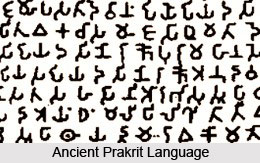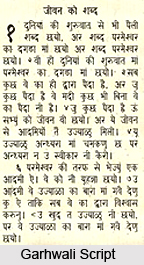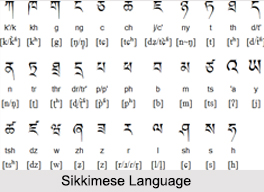 The Nagari script made its appearance in ancient India approximately around 8th century C.E. as an eastern alternative of the Gupta script (in which Sarada script was the western form). In turn, Nagari bifurcated out into umpteen scripts, most prominent of which was the Devanagari script, besides including Eastern Nagari, Nandinagari, Bengali and Tibetan scripts and also influenced the development of the Sarada-descended Gurmukhi script. As a separate theory, Nagari script is also believed to essentially be an early derivative form of the Devanagari script, which is still in use in modern Indian writings and linguistics.
The Nagari script made its appearance in ancient India approximately around 8th century C.E. as an eastern alternative of the Gupta script (in which Sarada script was the western form). In turn, Nagari bifurcated out into umpteen scripts, most prominent of which was the Devanagari script, besides including Eastern Nagari, Nandinagari, Bengali and Tibetan scripts and also influenced the development of the Sarada-descended Gurmukhi script. As a separate theory, Nagari script is also believed to essentially be an early derivative form of the Devanagari script, which is still in use in modern Indian writings and linguistics.
Nagari script, or Devanagari, as it is unanimously acknowledged now, is an abugida (standing for each letter exemplifying a consonant, whereas vowels are written with obligatory diacritics) alphabet of India and Nepal. The script is written from left to right, lacking in trenchant letter cases and is recognisable by an idiosyncratic horizontal line that is in line with the tops of the letters, binding them collectively. Nagari is the principal script used to pen Hindi, Marathi and Nepali. Beginning from the 19th century, the script has served as the most widely-used script for Sanskrit and Pali too. Nagari is also employed for umpteen other language and literature usages, like Gujari, Bhili, Bhojpuri, Konkani, Magahi, Maithili, Marwari, Newari, Pahari (Garhwali and Kumaoni), Santhali, Tharu, sometimes also including Sindhi, Punjabi and Kashmiri. The script was formerly also employed for penning Gujarati.
Nagari script fundamentally belongs to the Brahmic family of alphabets of Nepal, India, Tibet and South-East Asia. It is a celebrated successor of the Gupta script, together with Siddham and Sharada scripts. Eastern variances of Gupta inscriptions referred to as Nagari are first documented and evidenced from the 8th century. From c. 1200, these gradually took the place of Siddham, which outlasted as an effective medium of transmittance for Tantric Buddhism in East Asia and Sharada, which remained in parallel use in Kashmir.
Sanskrit nagari represents the feminine of nagara or "urban(e)", a vrddhi adjectival kind of nagara "city". It is feminine from its original formulating with lipi or "script" as nagari lipi "urban(e) script", standing for `the script of the cultured`. There are several versions of Nagari script in use today, one of which was differentiated by appending Deva "god" or "deity" to establish a tatpurusha compound, implying the "urban(e) (script) of the gods", or "divine urban(e) (script)".
The use of the name Devanagari is relatively recent, and the older term Nagari is still common. The rapid spread of the term Devanagari may be related to the almost exclusive use of this script to publish sacred Sanskrit texts in colonial times. This has led to such a close connection between Devanagari and Sanskrit that Devanagari is now widely thought to be the Sanskrit script; however, before the colonial period there was no standard script for Sanskrit, which was written in whichever script was familiar to the local populace.
The order of letters in Nagari script, just like almost all Brahmi scripts, is based upon phonetic principles, which study both the approach and place of articulation of the consonants and vowels they characterise. This system is generally referred to as the varnamala or "a wreath of letters". The arrangement of Nagari for Sanskrit serves as the paradigm for its application, with negligible variances or additions, to other languages.
As a Brahmic abugida script, (standing for each letter exemplifying a consonant, whereas vowels are written with obligatory diacritics), the cardinal precept of Nagari script is that each letter corresponds to a consonant, which carries an underlying vowel a. For instance, the letter k is red as ka, the two letters kn as kana and the three kny are red as kanaya, etc. Other vowels, or rather the lack of vowels, demand modification of these consonants or their own letters:
• Consonant bunches are penned with ligatures (samyuktaksara or "conjuncts"). For isntance, the three letters kny or kanaya can be joined to form knaya, kanya, or knya.
• Vowels other than the integral a, are penned with diacritics. From ka, the letters ke, ku, k?, and k?, are derived.
• There exists entire letters for vowels in absence of a consonant, either at the starting of a word or after another vowel. Hence, while the vowel u is penned with the diacritic in ku, it has its own letter in uka and kau.
• A culminating consonant is distinguished with the diacritic o, referred to as the virama in Sanskrit, halanta in Hindi, and a "killer stroke" in English. This negates the integral vowel, so that from knaya knay is received as a result. The halanta is frequently utilised for consonant bunches when typesetting ligatures is not executable.
Such a letter or ligature, with its diacritics, is named an aksara or referred to as "syllable". For instance, kny or kanaya is written with what are counted as three akshara, while, knya and ku are each penned with one akshara. As far as handwriting is concerned, alphabets in Nagari script are normally written without the idiosyncratic horizontal bar, which is only appended once the word is finished being scripted.



















